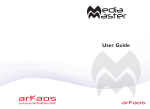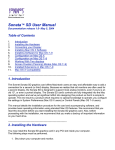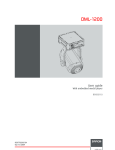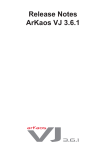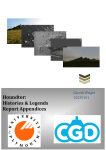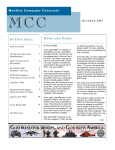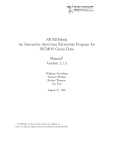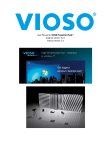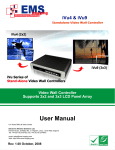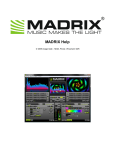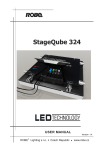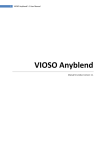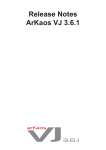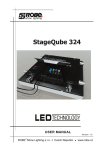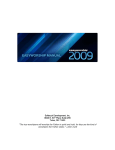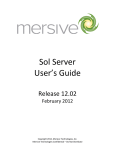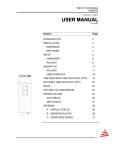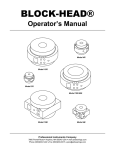Download "user manual"
Transcript
2 INTRODUCTION 6 INSTALLING THE SOFTWARE – PC 6 INSTALLING THE SOFTWARE – MAC 6 ABOUT YOUR LICENSE 7 Obtaining your serial number from the Media Fusion web site 7 Preparing your Machine ID code Generating your final serial number 7 7 Connecting a DMX console to Media Fusion 8 General Concept 8 1. Setting up your Robe Media Fusion DMX USB device on a PC 2. Setting up your Robe Media Fusion DMX USB device on a Mac OSX 9 9 INTRODUCTION TO THE SOFTWARE 10 Basics 10 Overview 11 Features summary 11 Driving LED panels 12 USING THE SOFTWARE 13 The main window 13 a. Previews area b. The master output area c. Layer parameter area 13 14 14 Media management 18 Basics Media Library Dialog Building your libraries File system 18 19 20 21 Text Library 22 3 The preferences dialog 24 The Display tab The DMX tab The Performances tab The LED Output tab The Registration tab 24 25 25 26 27 Menus 28 File Edit Display Help 28 28 28 28 WIDESCREEN & MULTISCREEN PRESENTATION 29 Introduction 29 Definitions 30 Wide screen Multi-screen 30 30 Case studies 31 Case 1: Dual head graphic card Case 2: Dual head graphic card + single head graphic card Case 3: Dual head graphic card + additional hardware Other possible combinations Monitors setup for wide screen or multi-screen projection 1. nVidia graphic cards 2. ATI graphic cards Horizontal Span Vertical Span 31 31 31 32 33 33 36 36 38 Soft-Edge 41 Calibration 42 PERFORMANCE TIPS 43 Movie Compression 43 Fixtures description 45 4 Layer Mini 1.0 45 Layer Tiny1.0 46 Layer Full 1.0 47 Master Small 1.0 49 Master Full 1.0 50 5 INTRODUCTION Welcome to Robe Media Fusion! Media Fusion is an intuitive media server environment that seamlessly integrates software and hardware for a professional quality, hassle-free performance. The Media Fusion environment is based around a media server software that allows you to mix, arrange, and apply effects to video clips and images. We have designed the Media Fusion software to be simple to use, while allowing for unprecedented variations and creativity with your visuals. And with an extended set of features such as live inputs, flash text animations and real-time visual effect generation, we hope that you will enjoy using this product as much as we’ve enjoyed building it for you! Sincerely, The Robe Team INSTALLING THE SOFTWARE – PC 1. To install the Media Fusion software, please insert the Media Fusion installation CD into your computer’s CD-ROM drive. 2. Double-click on the Media Fusion installation file, located in the root directory of the CD. This will launch the InstallShield Wizard. 3. Follow the on-screen instructions. Please note: The installation program will scan the available video components on your computer prior to installing the software. If there are any components that are not up to date, please install them by clicking on their corresponding button before proceeding with the installation. 4. Once the installation is complete, click “Finish”. The Media Fusion software is now ready to be used. 5. Start Media Fusion by going to Start -> Robe Media Fusion -> Media Fusion. Follow the registration process described further in this document in the next chapter 6. INSTALLING THE SOFTWARE – MAC 1. To install the Media Fusion software, please insert the Media Fusion installation CD into your computer’s CD-ROM drive. 2. Click on the Media Fusion installer located on the CD. 3. Follow the on-screen instructions. 4. Once installation is complete, you will see a shortcut on the desktop. The application will also appear in your Applications/Robe Media Fusion folder. 5. Start Media Fusion. 6 6. Follow the registration process described further in this document in the next chapter ABOUT YOUR LICENSE Your software box comes with a Purchase Key code. It is very important that you keep this code in a safe place since it is the proof that you own a license and it might be needed in the future to re-install the software or to obtain upgrades. The Purchase Key code, however, is not the final serial number that will register the software on your computer. To be able to run the software, you will need to create a serial number by following the instructions here after. Obtaining your serial number from the Media Fusion web site Preparing your Machine ID code Once the latest version of the software is installed on your computer, you will need to locate your Machine ID code: The Machine ID is an 8 capital letters code (e.g. ABCDEFGH) generated by the Media Fusion. This code is unique and is used to generate a final serial number, which will only work in combination with your computer’s Machine ID code. When you launch the application for the first time, it will present you with a “Registration” dialog. The Machine ID is displayed at the top of the dialog. Note that you can also run the software in demo mode at this stage. The software will still be fully functional but a ‘demo’ banner will be added on the output. Generating your final serial number You will first need to register the Purchase Key code that you found in your software box and create an customer account; 7 • • • • • • Prepare all the info you will need: The Machine ID of the computer you want to generate a serial for The Purchase Key that you received with the software package Go to http://mediafusion.robe.cz/register/ On the page, you will have the opportunity to either login to an existing account or to create a profile if you are not registered. Once you have created an account/login, you will be directed to a page listing all your license. If you don’t have one, you will need to first register your purchase key. Click on the ‘register license’ link and enter the purchase key that was in your box. This will create a license. You need now to create a serial number valid for your machine. To do that, click the link next to your license that says ‘create a new serial number’. You will be taken to a form where you need to enter the machineID displayed in the registration dialog as shown in the previous chapter. Once you’ve entered your machineID, a serial number will be automatically generated and you will receive a confirmation email with the generated serial number. Should you need to generate a new serial number, you can go back later to the registration page (http://mediafusion.robe.cz/register/), login and repeat the procedure. Connecting a DMX console to Media Fusion General Concept Thanks to its fixture-based operation mode, Media Fusion acts as a traditional Media Server for professional lighting consoles such as ETC, GrandMA, Martin, Compulite, etc. The fixture allows total control of every Media Fusion parameters straight from the DMX console. To be able to send DMX commands to the server, you’ll need to set it up so it can communicate with your console. Media Fusion supports two different type of DMX connectivity: either using ArtNet or using the Robe USB DMX interface. Using ArtNet If your console supports ArtNet, you simply have to connect an Ethernet cable from the console to the computer running the Media Fusion software. Media Fusion presents itself as an ArtNet Node that receives all incoming DMX data on a selected DMX universe. For your computer to appear on the 8 ArtNet network, you need to set its IP address to something like 2.X.X.X with an IP mask of 255.0.0.0 If you decide to use Media Fusion using the ArtNet protocol, go in the Preferences Dialog and, in the DMX tab, select ‘ArtNet’ as DMX Interface and set the subnet and universe you want to be listening to. For more information about ArtNet network configuration, check out the Artistic License web site at http://www.artisticlicence.com/. Using the DMX USB device The DMX USB device is a small DMX input port that can be connected to the computer through a USB port. To be able to use the device, you will need to follow a simple installation procedure. 1. Setting up your Robe Media Fusion DMX USB device on a PC The Robe Media Fusion DMX USB device is Virtual COM Port (VCP). Under Windows XP, compatible drivers are automatically installed at the same time as the main program so you just need to plug in your interface and it will show up in the software. Under Windows VISTA and Windows 2000, you might have to install manually the drivers. In that case, the device is listed in the device manager as “FT245R USB FIFO”. To install it, open the device, select “Update Drivers..” and select the drivers located in “Programs>Robe Media Fusion>Drivers”. Drivers are provided both for 32bit and 64bit operating systems. To use the device, start Media Fusion and select the Robe Media Fusion DMX USB in the DMX tab of the preference window. If the Robe Media Fusion DMX USB device installation was not successful or if the device is not correctly connected to the computer, the interface won’t be listed in the selection of DMX Interfaces. 2. Setting up your Robe Media Fusion DMX USB device on a Mac OSX On Mac OSX, you will have to install the FTDI VCP (Virtual Com Port) drivers. The drivers can be found on the Media Fusion installation CD in the “Utilities > Robe USB DMX Drivers” folder, there are two different installation files for either Intel or PPC. If the Robe Media Fusion DMX USB device installation was not successful or if the device is not properly connected to the computer, the interface won’t be listed in the selection of DMX Interfaces available in the Preferences dialog. 9 INTRODUCTION TO THE SOFTWARE Basics Media Fusion is a software that allows to seamlessly integrate real-time video in a light show by providing total control of the software from a DMX console. Serving up to 8 layers of videos and boasting a very wide array of effects and control parameters, Media Fusion is the ideal solution for lighting engineers wanting to blend video into light shows. Media Fusion is designed to work using a dual output computer setup. The main output will display the interface of the software and layer previews while the second output will send the full resolution image to an external hardware display like a projector, screen, video mixer, etc. For a discussion of different type of setups, see the ‘wide screen & multi-screen presentation’ section later in this documents. Medias (videos, images, flash files, cameras and streaming devices) are organized around the concept of libraries. Each library can contains up to 255 media that can be easily recalled from a DMX console by dialing its visual number. As we’ll see in a later phase, most media libraries are mapped to folders on the hard drive of the computer while some are reserved specific duties like serving camera feeds or acquisition boards. Media Fusion comes ready with some video material to start with but you can of course organize your libraries the way you want through the ‘Media Management’ dialog. This topic will be discussed in detail in the Media Management topic later in this document. 10 Overview The software is organized along one main window that display most of the information needed during a performance. It shows the 8 individual layers outputs as well as the master preview (the reflection of what is sent to the full screen output) and a parameter panel allowing accessing and modifying the settings for each layer. Parameters can be either modified through the user interface or from the DMX console. If you modify a parameter on the user interface, it will keep its value unless a change happens in DMX values. It then re-syncs to the value sent by the console. In order to drive Media Fusion from a DMX console, you will need to select in you console a fixture that is compatible with the software. We provide a couple of different fixtures mode in order to allow control of the software from small to high-end consoles. An extensive description of the fixtures is available later in this document in the ‘Fixture description’ section. Features summary The software provides for up to 8 layers of videos. Each layer can run one Visual and one effect, and gives DMX control over the following parameters: • • • • • • • • • • • • • • Visual selected (a visual is either a video, an image, a text, or an input from a camera or an acquisition board,…) Layer transparency (dimmer) Effect and parameters Position and size of the layer output Copy mode to blend with underlying layer Playback mode Movie Speed Chrominance and Luminance Keying Movie start and end frame Tiling Mapping on 3D objects (plane, sphere, cylinder) 3D Object rotation Color control Text (selectable text displayed in text animations) Additionally, after all layer have been composed, there is a master section allowing to control overall brightness and contrast, key stoning and soft edge parameters. When you start the software, the fullscreen output is not enabled. If you want to send the fullscreen output to the second output of your card, activate the 11 fullscreen either by selecting the menu Display>Toggle Fullscreen or by pressing CTRL+A (Command+A on Mac). If you don’t have a proper dual output setup, the fullscreen will be activated on the main screen and the main interface will disappear. To exit the fullscreen mode, press CTRL+A/Command+A again. For more information on setting up a proper dual output, see the Preference Dialog and the ‘wide screen & multi-screen presentation’ sections later in this document. Driving LED panels Additionally to sending high resolution video content to conventional projection devices, Media Fusion can also be used to drive LED Panels. When using the LED output mode, the display coming out of the video engine is sent to your fixtures according to a configuration stored in what is called a ‘mapping file’. The mapping file basically expresses what kind of LED panels are used, how they should be addressed and to what pixels on the screen they are related. Media Fusion supports two different system to send the video information to LED Panels: • • A generic system allowing to mix any type of LED panels as long as they are addressed via DMX (though ArtNet protocol or e:cue butlers). The second is a dedicated system for StageQube panels (PC only). In both cases, the procedure is the same: you first use an external program to define your panel configuration and then activate the generated mapping inside Robe Fusion to start sending the display to the LED panels. Once the LED output has been activated, you can use Media Fusion the exact same way as you do for regular video and the result will automatically be sent to the panels. More information on defining mapping file can be found in the specific documentation for each editor: the LED Mapper, for generic DMX, and QubeControl for StageQube panels. For information on how to activate LED Output in Media Fusion, see further in the Preference Dialog description. Important: driving LED panels is a special feature of Media Fusion that requires a special license. If you go to the Preferences Dialog and see the LED tab being disabled, it means your license does not support this feature. 12 USING THE SOFTWARE The main window The interface of the software has been laid out to provide a maximum number of information in a single window. Although the software has been conceived to be used through DMX control, all functionalities are available through the interface too. The main window is organized around three main areas: a. Previews area The top left part of the main window shows the visual selected on each of the 8 layers. We will refer to those as the “layer preview”. Next to each layer preview is a vertical slider that shows the mixing level (or transparency, or dimmer) of the layer. If the level is set to zero, no output is shown. As you drag the mixing slider up, the layer will become more bright and the layer underneath will disappear. 13 b. The master output area The master output area is located at the right side of the window. At the top, the preview shows the result of all the layer composition. It is the reflection of what is sent to the fullscreen output, usually connected to a projection device, and allows you to monitor what’s going on or to work with a single output setup when preparing your show. Under the master preview is a set of parameters acting on the master output: The brightness and contrast rotary buttons allow changing the luminosity balance of the result, and compensating for any loss that could be induced by the projection mechanism. The “mask” is a visual (usually a jpeg) that is used to block parts of the image so that no pixel is sent where the mask is black. This is very useful if you project on a screen that has a special aspect ratio or if you use non-square screens, and don’t want the image to ‘spill’ outside of the screen area. Masks are contained in the media library, in a reserved folder numbered 255. You can select between up to 255 different masks for each library. For more information about the media library, see the ‘Library Management’ section further in this document. The key stoning parameters allow to introduce key stoning directly from the software. Software keystoning has three big advantages: it is usually a lot easier than accessing the projection devices themselves, it doesn’t require a high end projection device that requires keystoning, and you can change the key stoning parameters from the desk, which is very useful with motorized beamers! When changing the key stoning value, you change the x and y position of the 4 corners of the image. The last two parameters are related to the soft edging. Soft edging is used when several projectors are used to build one big scene. In such cases, you often have to overlap the images sent by every projector in order to blend them correctly. The two soft-edge parameters allow controlling the blending zone in between each projector: the width parameter sets the width of the overlapping strip while the curve defines how strong the soft-edge blending should be. For more information about setting soft-edge, see the Preference Dialog. c. Layer parameter area Under the layer previews, you find the layer parameter area. This area displays all the settings for the ‘current’ layer. The current layer is the one whose mixing slider is red, as show in the picture above. To select another layer, either click in its preview window or on its mixing slider. The settings of 14 the current layer reflect all the control parameters accessible for that layer and will follow any DMX control sent from the console. The parameters are grouped in relevant sections for easier reading: Visuals This zone shows what visual is currently selected on the layer. Visuals are organized in libraries for easier access. There are 255 libraries available containing each up to 255 visuals. Some libraries are reserved for special usage (flash texts, acquisitions input and masking) but most of them are user configurable through the visual library management dialog (see further). To manually change the visual selected on the current layer, simply change the visual/library number using the arrows on the right side of the control. The layer preview should show you the visual running. If it doesn’t, make sure the mixing slider for the layer is not set to zero. Media Fusion comes with some pre-installed visuals that you can browse that way. To set up your own set of visuals, see the ‘Library Management’ further in this document. Effects This zone displays the effect setting for the current layer. Effects are also organized in libraries for easier grouping. Each effect can have up to 4 parameters that are displayed on the right side of the panel. You can select the effect to use by dialing its library/effect number and use the rotary button to modify the effect parameters. The range of effect available is depending on the fixture selected. For information on availability of effect, see the ‘Fixture Description’ section later in this document. Important: For performance reasons, effects are by default NOT applied on the preview of the layer. You will see the full composition, including effects on the master preview but not on the individual layer preview windows. If you have a very performing graphic card, you can change this behavior, in the Preference Dialog. See the Preference section for more information on this. Playback This zone contains the controls that affect the way visuals (mainly videos) are played. The ‘Loop’ setting control the way the video plays and loops. The available settings are, in order: 15 • • • • • • • Forward looping Backward looping Single shot forward (the video is played once then stops) Single shot backward Display first frame (useful when setting the segment start) Display last frame (useful when setting the segment end) Ping-pong (the movie plays back and forth) Next to the loop setting is the movie speed control. The movie speed rotaries allow to speed-up or slow down the movie. If set to zero, the movie will stop/freeze frame. Under the loop setting is a zone allowing controlling the segment of the movie to play. It allows setting the first and last frame to loop in between and therefore to set the playback to be only a part of the video file. When setting the first and last frame, it is interesting to use the ‘display first/last frame’ playback mode described above so that the frame you are adjusting is continuously displayed in the preview. Modes The modes setting defines how the current layer will be ‘composed’ with the previous layer. This section has two different settings: Copy modes: The copy modes express the basic composition between the current layer and previous layers. Robe Media Fusion supports the following options: • • • • • Copy mode: In this mode, the pixels of the layer are written on top of the previous layers. This is the default mode. The slider next to the layer preview acts as a transparency control for the layer. Addition mode: In this mode, the pixel values of the current layer are added to the ones of the previous layers. This means that “dark” pixels in the current layer image won’t alter the pixels that are underneath while “light” pixel will saturate the image underneath. Subtraction mode: In this mode, the pixel values of the current layer are subtracted from the pixel value in the underlying layers. Dark pixel from the current layer won’t alter the pixel of the layers underneath while light pixel will darken them. Multiplication mode: In this mode, the pixels from the current layer will be multiplied by the pixels of the underlying layers. For a pixel to appear bright in the output, the equivalent pixel of the current layer and the underlying layer needs to be bright. If any of the layers has a dark pixel, the result will be dark. Minimum mode: This mode takes the pixel that is the darkest between the current layer and the layer underneath 16 • Maximum mode: This mode takes the pixel that is the brightest between the current layer and the layer underneath. Mask modes: the masking modes allow setting up luminance and chrominance keying. Keying is a technique where some pixels are made transparent depending on some of their characteristics. Luminance keying ‘removes’ pixels based on their brightness level while chrominance keying removes pixels based on their colors. A typical example of chrominance keying is the ‘blue screen’ technique. The masking mode switches allow you to select, from left to right: no keying, luminance keying (band reject), luminance keying (band pass), chrominance keying (band reject) and chrominance keying (band pass). Band reject means that the selected luminance/color band will disappear while band pass will let the selection through. When luminance or chrominance keying is selected, a new widget will show up allowing selecting which part of the spectrum/brightness level should be affected: The widget has four points that can be moved. These points are always centered in the middle of the widget so, to define the center of the color/brightness scale, you need to click and drag inside the scale. The two top points will define the zone of the scale that is selected (filter width). In between those points, the color/brightness will be totally passed or rejected (depending on the mode selected). Then, the lower points allow to set the smoothness at which pixel will appear/disappear (filter slope). If the lower points too are close to the top points, the masking will be very abrupt and some artifacts might show up. Mapping The mapping setting allows projecting the visual and the effect on a 3D object. You can choose between a plane (this is the default mode), a cube and a sphere. When mapped, the video becomes a texture projected on the object. At this stage, you can also change the tiling (number of time the visual is repeated on the object) and adjust the color balance of the result. The color balance is a subtracting process in the RGB space. When lowering the ‘R’ value, you remove some red from the original colors. The color balance is kept unchanged when all of the rotary buttons are set to the maximum value. Position 17 The positional allows you to control the position of the layer’s output in a 2D or 3D space. The square position widget allows setting up both the layer’s position and size. This is the one to use if you want put the layer output in the top left corner for example. The slider next to it allows zooming in/out by specifying a Z (depth) offset. The three rotaries on the right side specify 3 rotation angles in the 3D space. Note that next to each rotary is a switch that allows the rotary to act either as an absolute angle setting or as a rotation speed Text The last parameter is related to texts. Robe Media Fusion allows you to store 255 different texts messages to use in conjunction with special flash files (called flash texts). This parameter allows you to specify which text should be used on the current layer. For more information on the texts capabilities of the software, see the ‘text library’ section further in this document. Media management Basics As we’ve seen earlier, Media Fusion uses a library paradigm to specify which media should be selected on a layer. The library is made of 255 library folders containing each up to 255 visual. Libraries are numbered from 0 to 255 and visuals are numbered from 1 to 255. No matter what library you are in, selecting the visual number 0 means that no visual is selected at all. The selection of the media to be played on a layer is done either through the user interface (see description above) or by DMX by dialing its visual and library number. There are two ways of modifying the library content: either through a the dedicated media management window or directly by setting up files in the files system; both are valid but using the media management is easier and allows you to alter the media library content even while the software is running. 18 Media Library Dialog The media library dialog is called by selecting the menu Edit > Library Management… or by selecting the keyboard shortcut (CTRL+L/Command+L). Overview The library window looks like the following: The left pane of the window shows the 256 library folders with selected folder highlighted in blue. You can scroll through the list and select any of the folders by clicking on its icon. The right pane displays the thumbnails of the visuals belonging to the selected folders. There are 255 of them (the fist one is always considered as an empty slot). And you can scroll through the content using the scroll bar on the right side of the window. If you put you mouse over an existing visual, you will see it’s full filename as well as its resolution. As you can notice, the first part of the file name (or folder names for that matter) will always be a number. This is part of the naming convention used by the media server, as we’ll see later on. With the default installation content, the first five folders are preloaded with the default content and the others are empty so you have the possibility to add content of your own. All regular content folders are indicated by a folder icon, and display the library number as well as its name. This is the case for most folders. You can add, remove, and duplicate your content inside those folders as you wish. 19 If you scroll the folder list all the way down, you will also notice that some libraries have special icons. This means they are used for specific purposes: The last library is the ‘mask’ library. Its content is used to provide the master output mask as described earlier in the ‘master output area’. Masks are more likely to be black and white images as they are multiplied with the image resulting of the composition of all layers. With that respect, the mask acts as a transparency film where a white is fully transparent and a black pixel is fully opaque. Above the mask library is the ‘camera’ library. This library is a virtual folder (in the sense that it doesn’t refer to anything on the file system) that will list all available video inputs found on the machine. Video input is seen here in a very broad sense; it can be an acquisition board, a usb web cam, a Firewire cam or any other video inputs seen be the system. If you want to feed one layer with an existing input, just select the library 254 and the camera number as listed in this folder. Folders from 250 to 253 are reserved for flash texts. Flash texts are special visuals in which you can dynamically change the text string. They are intended to be used together with the text library (see further for more explanations). Although you could place the flash text in any other library, we thought it would be more convenient to group them in a special location making it easier to browse. The default library contains a good set of example files, all located in library number 250. Folders from 240 to 249 are reserved for future development. We prevent to load anything in those folders making sure future development would not clash with existing customer configurations. Building your libraries Managing the content is fairly easy. You can add, remove and rename medias directly with the user interface. Bear in mind that Media Fusion opens all the medias at startup and might have memory issues if you start putting too much content with respect to your machine specification. If you need to work on several shows, it is probably better to build several dedicated libraries rather than filling one with all the content. Adding visuals to the library To add content to any of the folder, you have several options: 1. Drag and drop files from the explorer/finder window on the folder where you want them to be. By doing so, the files you drag and drop will be copied in the first empty slots available in the folder. 20 2. Drag and drop files to a specific slot in the folder content. This allows you to specifically set the starting slot of the file or to overwrite existing files. If you drop the files to an empty slot, the files will be set in all empty slots starting with the one where files were dropped. If you drop the file to a slot containing already a visual, you will be asked if you want to overwrite the existing file(s) or start at the first empty slot after the one you dropped the files on. 3. Right click (ctrl+click on Mac) on a slot and select ‘Import/Replace Visual...’ from the context menu to import a single file to a give location. Important note: when you delete or overwrite files in the media library, the files will be physically erased from the hard drive. Make sure you always have a copy of your original files somewhere else. Also, if you drag files from the explorer to the media library, the files will be copied from their original location to the media library, preserving the original files. Removing visuals to the library To delete content from the library, right-click/ctrl-click a slot with the visual you would like to delete and select ‘Remove Visual…’ from the context menu. Again, be warned that removing the visual will physically erase it from the hard drive. Moving visuals in the library To move a visual inside the library, simply drag and drop it within the folder. To move the visual to another library folder, simply drag and drop it from its slot to one of the folders in the left pane. The visual will be assigned to the first free slot in the target folder. Renaming folders To rename a folder, simply right-click/ctrl-click the folder and select ‘Rename…’ from the context menu. File system The library structure is reflected on the hard drive where all files for the library are stored. The whole library is contained within a special folder called the ‘root folder’. If you go look in the installation folders, you will see the default root folder called media. Inside the root folder is a collection of folder each starting with a 3-digit number followed by an underscore and a name. Each folder following this convention represents a library folder (as seen in the left pane of the media management dialog) and the 3-digit number represents the id of the folder. Because of this, you can’t have folders without the 3 digit number scheme. You can’t neither have two folders starting with the same 21 digit (one of them will be ignored). Inside each folder is the collection of media that the library folder holds. The media also follow the 3-digit conventions with the digits representing the visual number inside the library. Note that for visuals the digit starts at 001_ since visual 0 is always considered as being empty. If you wish, you can organize your libraries by modifying the files on your hard drive directly. However, the changes you do there are not updated automatically in the software while it’s running. If you want to software to take into account changes done on the file system, go in the media management dialog and click on the ‘refresh library’ button at the bottom of the window. Changing the root folder As seen earlier, Media Fusion loads all the visuals in the library at startup to ensure a smooth startup of medias when triggered. Because of that, and depending on the capacity of your hardware, having a huge library can have a very big impact on startup time and memory usage. If you are doing several shows using Media Fusion, we recommend building several library structures so you don’t hog the memory with files you won’t need. To switch between different libraries, you simply need to specify a new ‘root folder’ using the button at the bottom of the media management dialog. When specifying a new root folder, the current library content will be unloaded and the content in the new root folder will be loaded instead. Important: For the library to be properly loaded, it is mandatory that the folders and files located under the root folder follow the 3 digits convention as explained in the previous paragraph. If you don’t see a folder or file in the library, it is most likely you didn’t follow the proper file naming. Text Library The text library is a dialog use to enter text that can later be combined with special media files called ‘flash texts’. As we’ve seen in the Media Management section, these medias are by default present in the library number 250. When selecting one of these media, you can use the text parameter of the layer to change the displayed text by one of the strings defined in the text library. The content of the text library can be edited using a special dialog that can be recalled by selecting the menu Edit>Text management or, alternatively, by pressing CTRL+T/Command+T. The dialog lists the 255 text entries of the library that can be edited by simply replacing the text item next to the item number. 22 When pressing ‘OK’ in the dialog, the text library will be updated and the new text item can be selected. 23 The preferences dialog The preference dialog is used to setup all the option of Media Fusion. It is organized around tabs that contains relevant set of information. The Display tab The display tab contains the setup related to the fullscreen mode of the software. As we said earlier, the software is mainly done to be used with a two video output scheme. The first video output is used to display the main interface containing all the previews and parameters while the second video output is used to send the fullscreen image to a projection hardware. This dialog is used to specify the characteristics of the adapter used for the fullscreen. Full Screen Monitor: this specifies on which of the adapter the fullscreen will be displayed. Normally the select box should contain at least two entries. If it does not, it means the system doesn’t think you have two-output setup. To correct this, go into the system properties and make sure the display settings are such as you have two monitors recognized by the system. Make also sure your displayed are setup to provide dual-mode and not cloning. For more discussions on screen setup, see ‘WIDESCREEN & MULTISCREEN PRESENTATION’ later in this document. Resolution: this setting specifies the resolution at which the graphical engine should run. The lower it is, the faster the engine can go and the better the frame rate gets but the lower the quality of the result is. You can use this setting to adapt the result, depending on the power of your computer and the resolution of the output. Force Resolution: if this option is enabled (default) the software will resize the monitor output to the engine resolution when going to fullscreen. Unless specific case, it is better and more efficient to leave it on. Use Custom Resolution: use this option if you want to specify manually the internal engine speed to a resolution that is not a monitor resolution. In the case this option is selected, the ‘Force Resolution’ option will automatically be disabled. Soft Edge Span: specify how many projectors are used to map the whole screen vertically and horizontally. Unless you use projector with soft edging, you should leave this option to 1 for both field. 24 The DMX tab The DMX tab contains all information related to the connection between Media Fusion and you console. It specifies the interface to be used, the type of fixtures, the number of layers and so on. Interface: this section is used to select which interface you would like to use for communicating with your console. Robe Media Fusion supports the ArtNet protocol and the Robe DMX USB. The latter one will only be displayed if it is properly detected by the system. If you have one and don’t see it listed, check the installation tips at the beginning of this document. If you use the ArtNet protocol, you have to select the subnet and universe you want Robe Fusion to be listening to. Patch: In this section you can select the fixture to use for the control of the layers (see the Fixture section for a full description of the various fixture modes supported by the software). You can also specify the number of layers to be slaved to DMX (if you need only two layers and want to spare DMX channels for other usage) and what is the base channel to use. You can also specify if you want the master fixture to be active and what is its base channel. The Performances tab The performance tab shows various setting allowing tuning the performance of the software with respect to your machine. The first field shows the GPU level of the machine. This is an indication of the power of your graphic card and ranges between 0 and 5. If your level is anywhere under 3, you might have some features and effect that are disabled as the graphic card doesn’t support all of the software’s features. Although it will run even on machine with a GPU level of 0, we strongly recommend to use a graphic card that provides at least 3. 25 Preview style: This setting control the way layer previews are show. Displaying layer preview involves quite a bit of processing and the style of the preview used can influence greatly the average frame rate of the software. The default is to show only the media running. This is useful since it allows you to quickly know which layer runs which visual. However, if your computer is not very powerful, you might want to disable the layer preview by selecting ‘off’. If your graphic card is very powerful, you can try to have the layer preview displaying both the media and the effect applied on it by selecting ‘full’. Be sure however to check the impact on the framer ate as it involves retrieving a lot of information from the graphic card and this process can be quite slow. Preview quality: the preview quality setting applies to the master preview. Lowering the master preview quality will speed up the processing but will result in a pixilated preview. You should try to lower it if your computer struggles too much to deliver the videos. If you put the preview quality to zero (all the way to the left) the master preview will be turned off. The LED Output tab The LED Output tab allows you to activate the LED output module of the software. Note that this is a special feature of the software that needs a special license. If the controls of this dialog are disabled, it means your license does not allow you to use it. Activate: When enabled, it triggers the LED output module of the software. When activated, the video engine will be restarted and the LED broadcast will be started. If any error happens, it will be reported. Output Type: Selects the type of output. If you defined a mapping using Robe’s LED Mapper, select ‘LED Mapper’. If you use StageQube panels and generated a mapping with QubeControl, select ‘StageQube’. Please note that switching to/from ‘StageCube’ will require re-starting the application. Parameters: The parameter panel content depends on the output type selected. If you selected ‘LED Mapper’, the only parameter is the mapping file to be used. If you selected ‘StageQube’, you can also tune some generic panel parameters. 26 The Registration tab The registration tab simply displays your registration serial number as well as the machineID of your hardware. It can’t be changed and is displayed only for information purpose. 27 Menus File The file menu is only available on a PC. It contains access to the Preferences dialog and provides the Quit entry to exit the software. On a Mac, those menus are located in the application specific menu. Note that to prevent any accidental exit, you can’t exit the software when running in fullscreen mode. Edit • • • Resync to DMX: As we’ve seen earlier, even when you slave the server to the DMX console, you can still use the user interface to modify parameters of layers or the master controls. If you do so, the parameter will keep the modified value until this particular parameter is modified from the DMX (i.e. the DMX channel value for that parameter changes). If you wish all parameters to be re-synchronized automatically to the current DMX values, select this entry. Library Management: Brings the media library dialog as discussed in the ‘Media Management’ section earlier in this document. Text Management: Brings the text library dialog as discussed in the ‘Text Library’ section earlier in this document Display • Toggle fullscreen: Toggles between the fullscreen mode and regular mode. Help • • • • Documentation...: Brings the PDF version of this document Release notes…: Brings the release notes for the current software version Media Fusion Website: Starts a browser on the Robe Media Fusion web site. About: Shows the about dialog 28 WIDESCREEN & MULTISCREEN PRESENTATION Introduction In a common Media Fusion setup, a computer with two video outputs is generally used: one output for the desktop monitor (to display the interface and control the software) and another output which receives the result of the visual mix. That second output is generally connected to a video projector, a large screen or a hardware video mixer. In this case, you will be using the single second output to send your final mix and, after having defined the adapter to use and its resolution, you are ready to go. Media Fusion, however, offers custom output resolution possibilities. This allows creating multi-screen or wide screen setups controlled through a single computer running Media Fusion. In this chapter, we’ll investigate those specific setups. Important: Wide screen or multi-screen setups require to output in a high resolution and therefore a recent / powerful graphic card is necessary; a setup including 2 screens each in 1024x768 will require Media Fusion to output in 2048x768, which will use a lot of CPU and GPU resources. 29 Definitions Wide screen A wide screen setup consists of one large visual mix spanning across several screens placed next to the other. This is achieved by generating a single Media Fusion projection in very a large resolution, which spans across several video adapters. If you plan to use projectors as outputs devices, you also have a Soft-Edge option, which allows seamless edge blending between the two projectors. Multi-screen The multi-screen setup is the same concept as the wide screen in the sense that it drives several adapters but in this case you end with different visual mixes displayed on each output. 30 The way it works is that you use the position capabilities of Media Fusion to assign layers to part of the screen, which is divided across the various adapters. Case studies In order to explain the different steps to setup Media Fusion to produce a wide screen or multi-screen projection with several displays, let’s examine some common hardware configurations. Case 1: Dual head graphic card If you only have a dual head graphic card and would like to achieve multiple outputs, you will need to use both adapters and, since you have no more monitor available left, you will lose the display the interface. If you programmed your show in your DMX console and don’t need visual feedback from the program, this is an option. Case 2: Dual head graphic card + single head graphic card Adding a supplementary graphic card to the setup described above will allow you to use it with your desktop monitor in order to display the Media Fusion interface and control the software while you use the dual head graphic card and its two outputs for the wide screen or multi-screen. Important: at this stage, this option is only available on PC. The Mac version does not support accessing more than one graphic adapter. Case 3: Dual head graphic card + additional hardware Using an external hardware such as the Matrox DualHead2Go allows splitting one video output into two separate signals (the DualHead2Go is a palm-sized 31 box that sits outside of your system and has one VGA input and two VGA outputs). This system allows computers with a dual head graphic card to use one of the graphic card output for the software interface and its second output to send the visuals that will be split across two different screens. This very affordable solution will also fit perfectly with most modern laptops. Other possible combinations • • Dual head graphic card with each output split in two with a DualHead2Go; you would have a 4 screens setup. Matrox also provides the TripleHead2Go multi-display upgrade allowing splitting a single display adapter across 3 different screens. This can lead to up to 6 screens if you are using a dedicated two-heads display adapter for the output. 32 Monitors setup for wide screen or multi-screen projection Earlier in this document, we’ve seen how to choose and setup a second monitor to display the Media Fusion visual mix. To do wide screen or multiscreen, the principle is the same in the sense that Media Fusion will continue to outputs one large visual mix, but the visual is going to span across the multiple heads of an adapter. The way to execute the span across adapters is very different for Mac and PC’s so we’ll examine them separately. Monitors setup under Windows Under windows, it is the graphic card that is responsible for spanning the big display across the various heads. In a sense, you create one “virtual display” covering two “physical displays”. In Windows terms, this is called Horizontal Span or Vertical Span, depending on the display orientation you will select. As an example, we will explain the different steps to configure a virtual display over multiple screens both with nVidia and ATI graphic cards. Other graphic cards may be capable of achieving such a setup and the configuration settings should not be too different from the ones explained below. In any case, please refer to your graphic card’s manufacturer documentation. Finally, it is important to setup these options before launching Media Fusion since it will try to detect your displays during the startup. 1. nVidia graphic cards 1. In the Windows Control Panel, open the “Display Properties” window and go to the “Settings” tab. Generally you will see a classic dual monitor setup such as the one below. 33 2. Click on the “Advanced” button and select the nVidia tab on the top right, this window will open: 3. In the menu next to “nView Display Mode”, select “Horizontal Span” or “Vertical Span” and click Ok to apply. • If you selected “Horizontal Span”, the two physical screens will be merged side by side in a single large display and the Windows display settings window will show a large screen 34 In this case, the resolution is 2560x1024 because we used two 1280x1024 screens. • If you selected “Vertical Span”, the two physical screens will be merged on top of each other in a single tall display and the Windows display settings window will show a tall screen. 5. Once you have achieved this setup and closed the display settings window by clicking Ok, you can launch Robe Media Fusion. The resolutions available 35 for the adapter will now list the wide set of resolution you created with the horizontal span. 2. ATI graphic cards Setting up Horizontal or Vertical Span with ATI graphics cards is done through the “ATI Catalyst Control Center” that you can launch from Windows’ program menu or from the ATI icon in your system tray (next to the clock in the task bar). Horizontal Span 1. Once the “ATI Catalyst Control Center” window is open, to setup a simple Horizontal Span, select the Basic mode then click Next. 36 2. The display configuration wizard will be displayed, click Go to start: 3. In the Available Display Devices list, select which one is your primary monitor then click 37 4. In the Desktop Mode Selection dialog, select the last option “Horizontal Stretch” then click Next: 5. You will end with a single display spanning horizontally over two monitors, you can now launch Media Fusion and select the new set of resolutions availble. Vertical Span 1. To setup a Vertical Span, select “Advanced” instead of Basic on the ATI Catalyst Control Center first screen then click ‘Next’. 2. Select the “Displays Manager” section in the tree menu under the “Graphics Settings” tab; you will see your monitors listed. 38 3. Right-click on your secondary monitor and select the option “Stretch Desktop 1 vertically onto monitor” in the menu. Of course, you can also setup a horizontal stretch from that menu. 4. Close the dialog box by clicking Ok, you can now launch Media Fusion and select your “virtual monitor” from the Monitors Setup dialog box. Monitors setup under Mac OS X 1. From the Apple menu, open the System Preferences and select “Displays”, once in the Displays window, go to the tab “Arrangement”. It is very important here to ensure that your monitors are represented in the same position as they are positioned physically; you may need to drag the monitors around with your mouse to place them correctly. In this case the primary monitor is placed to the left of the secondary monitor. 39 Important: You will need later to specify manually the resolution corresponding to the sum of your two monitors. So make sure you take note of it at this stage. For example, if you have two monitors of resolution 1024x768 placed side by side, your total resolution will be 2048x768. You can now close the System Preferences Displays window and launch Media Fusion. 2. In Media Fusion, go to the Preference Dialog and select the display tab. First, select as output monitor the monitor that is positioned at the top left of the full display. Then select the custom resolution setting and enter the resolution corresponding to the sum of the two monitors (2048x768 in our example). 3. Start the fullscreen and the window will be created across the two monitors. To have it correctly spanned across your two monitors it is important that they have been positioned as they should at step 1 and that your Media Fusion resolution corresponds to the addition of the resolution from each of your two monitors. 40 Soft-Edge To create a large screen by combining several video projectors it is important to be able to seamlessly blend the edges between each projection. This can be achieved through the use of the Soft-Edge option as it creates an overlapped area on the border of each screen with a fade on the edge that can be overlapped with the next image. Here is an original image (a nice view of Prague’s skyline): And here’s an example of what would be displayed with a two beamers setup: The areas to blend are displayed in the middle of the visual, positioning the beamers so that these two areas are superposed will re-create the original picture without any visible separation in the middle of the visual. 41 Of course, it’s highly recommended to use two identical projectors. You enable the Soft-Edge by the number of projector used horizontally and vertically in the “Display Tab” of the Preferences Window: Once this has been setup, you can control the soft edging characteristics by changing the width and curve of the soft edge on the main interface: The width of the overlapping area is defined between 2% and 50% of one screen size. The curve factor defines the fade curve value allowing to fine-tune the luminosity of the overlapping area compared to the rest of the picture. Calibration Below are the common steps to setup a wide screen with Soft-Edge in Media Fusion (provided that you have correctly setup your system and your graphics card driver parameters as explained earlier in this document). 1. Launch Media Fusion 2. Setup the number of horizontal and vertical screens, and the soft-edge settings in the “Display tab” of the Preferences Window 3. Import a picture appropriate for calibration and activate it 4. Launch the fullscreen mode ([Ctrl]+A or [Apple]+A in Media Fusion) (At this point, you should have the picture displayed on the two beamers with the soft-edge effect) 5. Place the beamers correctly so that the edges blend seamlessly area are superposed 6. Adjust the Curve parameter to obtain the desired luminosity on the overlapping area 42 PERFORMANCE TIPS Achieving good performance with video can be difficult because as it depends on a lot of different factors. The most important factors are: • CPU speed • Disk speed • RAM access speed • Video hardware & video bus speed • Movie compression There is no easy way to give a definitive answer in terms of what is best for every computer setting. In Robe Media Fusion, most of the graphic processing is done in the graphic chip of the video hardware, so the more powerful it is, the better performance you are going to get. The CPU is mainly used to decompress movie frames from the disk and send them to the video card. The faster your drives are, the faster frames will be loaded in the memory and the faster your CPU is, the faster it will decompress the frames. To achieve a good frame rate with a given hardware, you can: • Adapt the resolution of the internal computation. See (Preferences/Display) • Use a source material that is adapted to your hardware. If you have a slow disk or older generation of hardware, try working with smaller video sources to minimize the impact of loading and decompressing the movie. Since all calculations are done inside the graphic card, the automatic filtering applied when the images are scaled to the final resolution will minimize aliasing effects. It is very important to note that popular compressions schemes such as mpeg, divx and DV codecs, are very inefficient for Media Servers. Video files using these compression schemes will behave ‘correctly’ when used at nominal speed (100%), but will be very sluggish if you change their playback speed play them backwards. If you use these compression formats, you will get poor performance from the software. Movie Compression Beside movie size, their compression scheme has a huge impact both on the fluidity of the display and their playability. The more complex the compression scheme, the more work the processor will have to do to recover specific frames; resulting in sluggish performance. In addition to the compression method itself, there’s the issue of key frames. Most widely spread compression mechanism work using incremental methods, which means they 43 construct a frame by storing the difference between a frame and the previous one. In order to keep the process from deriving too much from the original material, they store an original frame every now and then, and start again coding incremental information from that frame on. These original frames are called ‘key frames’. Using sparse key frames will mean that for Fusion to access a given frame, it will have to find the previous key frame and process all the intermediate frame differences until it reaches the desired one. As you can imagine, this process is rather slow and prevents fast access to frames, which is very important for backward playback or scratching. That’s why compression schemes like mpeg or DivX are not at all suited for video performances. From our experience, the best compression scheme for video performance is QuickTime’s Photo JPEG with a quality setting of about 80% or more. This will ensure smooth playback, effective scratching and decent file size. If you want to used high definition content (HD) you can also use the H 264 codec that is part of Apple QuickTime 7.x 44 Fixtures description Layer Mini 1.0 Chan. # Funct. 1 Dimmer Controls layer transparency 2 Visual Library Visual folder Snap / Instant Def. Value 0-255 No 0 0-239 User/File folders Yes 0 0-255 Yes 1 0-15 None 16-31 RotoZoom 32-47 Cube Inside 48-63 Tile Scrolling 64-79 Plane 80-95 Tunnel 96-111 Kaleido 112-127 Radial Blur 128-143 Motion Blur 144-159 Mirror 160-175 AsciiArt Squares-BW 176-191 Split Scrolling-1 192-207 Greyscale 208-223 Invert 224-239 RGB Cycle 240-255 Larsen Simple Yes 0 Description Range 240-249 Reserved (future) 250-253 Text folders 254 Cameras 255 Masks 3 File 4 Effect File number (in selected folder) Effect number 45 Layer Tiny1.0 Chan. # Funct. Description Range Snap / Instant Def. Value No 0 Yes 0 1 Dimmer Controls layer transparency 2 Visual Library Visual folder 3 File File number (in selected folder) 0-255 Yes 1 4 Effect Library Effect Category 0-31 3D Yes 0 Yes 0 0-255 0-239 User/File folders 240-249 Reserved (future) 250-253 Text folders 254 Cameras 255 Masks 32-63 Video 64-95 Color 96-127 Artistic 5 Effect Number of the effect (in selected category) 0 No effect 1-255 Effects 1-255 6 7 8 9 10 11 12 13 14 15 16 Effect Parameter PositionX coarse PositionX fine PositionY coarse PositionY fine PositionZ coarse PositionZ fine ScaleX coarse ScaleX fine ScaleY coarse ScaleY fine 17 Red level 18 Green level 19 Blue level 20 Text Controls the effect 0-255 No 128 Horizontal position of the layer 0-255 No 128 0-255 No 128 0-255 No 128 0-255 No 128 0-255 No 128 0-255 No 128 0-255 No 128 0-255 No 128 0-255 No 128 0-255 No 128 0-255 No 255 0-255 No 255 0-255 No 255 0-255 Yes 0 Vertical position of the layer Zoom Horizontal size of the layer Vertical size of the layer Red level, from 0% to 100% (normal value) Green level, from 0% to 100% (normal value) Blue level, from 0% to 100% (normal value) Number of the text entry to use in text animations 46 Layer Full 1.0 Chan. # Funct. Description Range Snap / Instant Def. Value 1 Dimmer Controls layer transparency 0-255 No 0 2 Visual Library Visual folder 0-239 User/File folders Yes 0 240-249 Reserved (future) 250-253 Text folders 254 Cameras 255 Masks 3 File File number (in selected folder) 0-255 Yes 1 4 Effect Library Effect Category 0-31 3D Yes 0 Yes 0 Yes 0 0-255 No 0 0-31 Copy Yes 0 Yes 0 32-63 Video 64-95 Color 96-127 Artistic 5 Effect Number of the effect (in selected category) 0 No effect 1-255 Effects 1-255 6 Text 7 Shape Number of the text entry to use in text animations 3D Shape for the layer 0-255 0-31 Plane 32-63 Cube 64-95 Sphere 8 Tiling 9 Copy Mode Tiling (repeats the visual multiple times) Defines how the layer is blended with the background 32-63 Add 64-95 Subtract 96-127 Multiply 125-159 Minimum 160-191 Maximum 10 Mask Mode Masking type: luma-key or chroma-key 0-31 None 32-63 Luma BR (band reject) 64-95 Luma BP (band pass) 96-127 Chroma BR (band reject) 47 128-159 Chroma BP (band pass) 11 Mask center 12 Mask width 13 Mask Smooth 14 Speed 15 Loop Mode Center of the masking filter Width of the masking filter Smoothness of the masking filter Playback speed for movies Defines if movie should loop and more No 0 No 32 No 32 No 64 0-255 No 0 0-255 No 0 0-255 No 255 0-255 No 255 0-255 No 128 0-255 No 128 0-255 No 128 0-255 No 128 0-255 No 128 0-255 No 128 0-255 No 128 0-255 No 128 0-255 No 128 0-255 No 128 0-63 Constant Rot. CCW No 128 64-191 Rotation value No 128 No 128 0-255 (64 for normal speed) 0-31 Loop forward 32-63 Loop backward 64-95 Once forward 96-127 Once backward 128-159 Ping-Pong 160-191 Display first frame 192-223 Display last frame 16 17 18 19 20 21 22 23 24 25 26 27 28 29 30 31 Loop Start - coarse Loop Start - fine Loop End coarse Loop End fine PositionX coarse PositionX fine PositionY coarse PositionY fine PositionZ coarse PositionZ fine ScaleX coarse ScaleX fine ScaleY coarse ScaleY fine RotationX coarse RotationX fine Loop start point Loop end point Horizontal position of the layer Vertical position of the layer Zoom Horizontal size of the layer Vertical size of the layer Rotation around X axis 192-255 Constant Rot. CW 32 RotationY coarse Rotation around X axis 0-63 Constant Rot. CCW 48 33 RotationY fine 64-191 Rotation value No 128 0-63 Constant Rot. CCW No 128 64-191 Rotation value No 128 0-255 No 255 0-255 No 255 0-255 No 255 First effect parameter 0-255 No 128 Second effect parameter 0-255 No 128 Third effect parameter 0-255 No 128 Fourth effect parameter 0-255 No 128 Transition mode 0 Yes 0 Snap / Instant Def. Value Yes 0 0-255 (0 for normal value) No 0 0-255 (128 for normal value) No 128 192-255 Constant Rot. CW 34 35 RotationZ coarse RotationZ fine Rotation around X axis 192-255 Constant Rot. CW 36 Red level 37 Green level 38 Blue level 39 40 41 42 43 FX Parameter 1 FX Parameter 2 FX Parameter 3 FX Parameter 4 Transition Red level, from 0% to 100% (normal value) Green level, from 0% to 100% (normal value) Blue level, from 0% to 100% (normal value) Master Small 1.0 Chan. # 1 Funct. Mask Description Mask file number (in library folder 255) Range 0 No Mask 1-255 File number 2 Contrast 3 Brightness Contrast of the whole output Brightness of the whole output 49 Master Full 1.0 Chan. # Funct. 1 Mask 2 3 4 5 6 7 8 9 KeystoneX1 KeystoneY1 KeystoneX2 KeystoneY2 KeystoneX3 KeystoneY3 KeystoneX4 KeystoneY4 10 Contrast 11 Brightness 12 SoftEdge width 13 SoftEdge curve Snap / Instant Def. Value 0 None Yes 0 1-255 File number 0-255 0-255 0-255 0-255 0-255 0-255 0-255 0-255 No No No No No No No No 0 0 0 0 0 0 0 0 0-255 (0 for normal value) No 0 0-255 (128 for normal value) No 128 0-255 No 100 0-255 No 128 Description Mask file number (in library folder 255) Keystone X1 Keystone Y1 Keystone X2 Keystone Y2 Keystone X3 Keystone Y3 Keystone X4 Keystone Y4 Contrast of the whole output Brightness of the whole output Width of the softedge overlapping area Defines the correction blending curve Range Version 1.0 Specifications are subject to change without notice. 50 51



















































